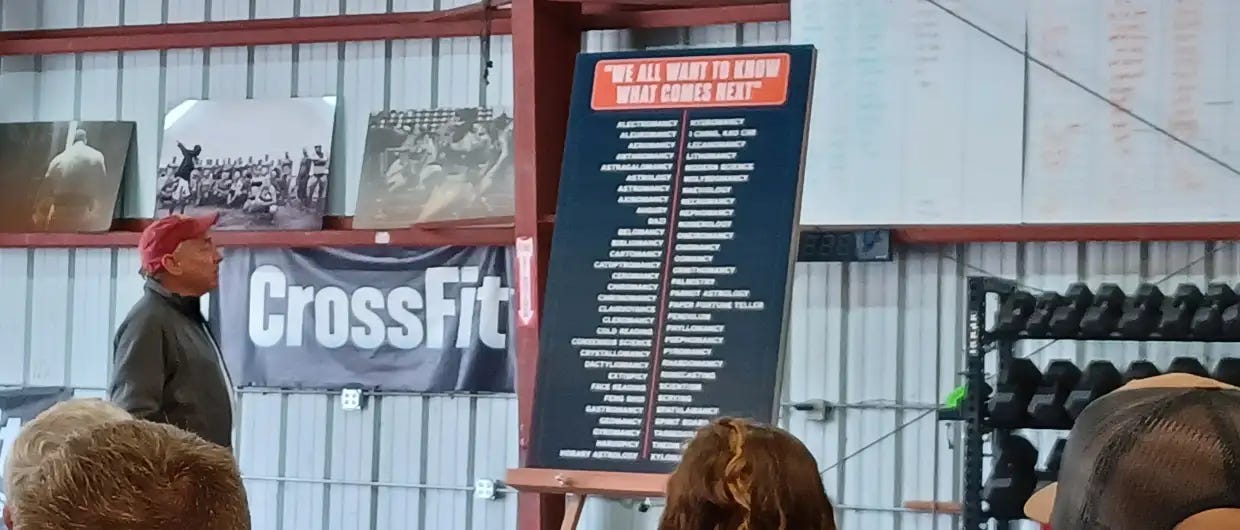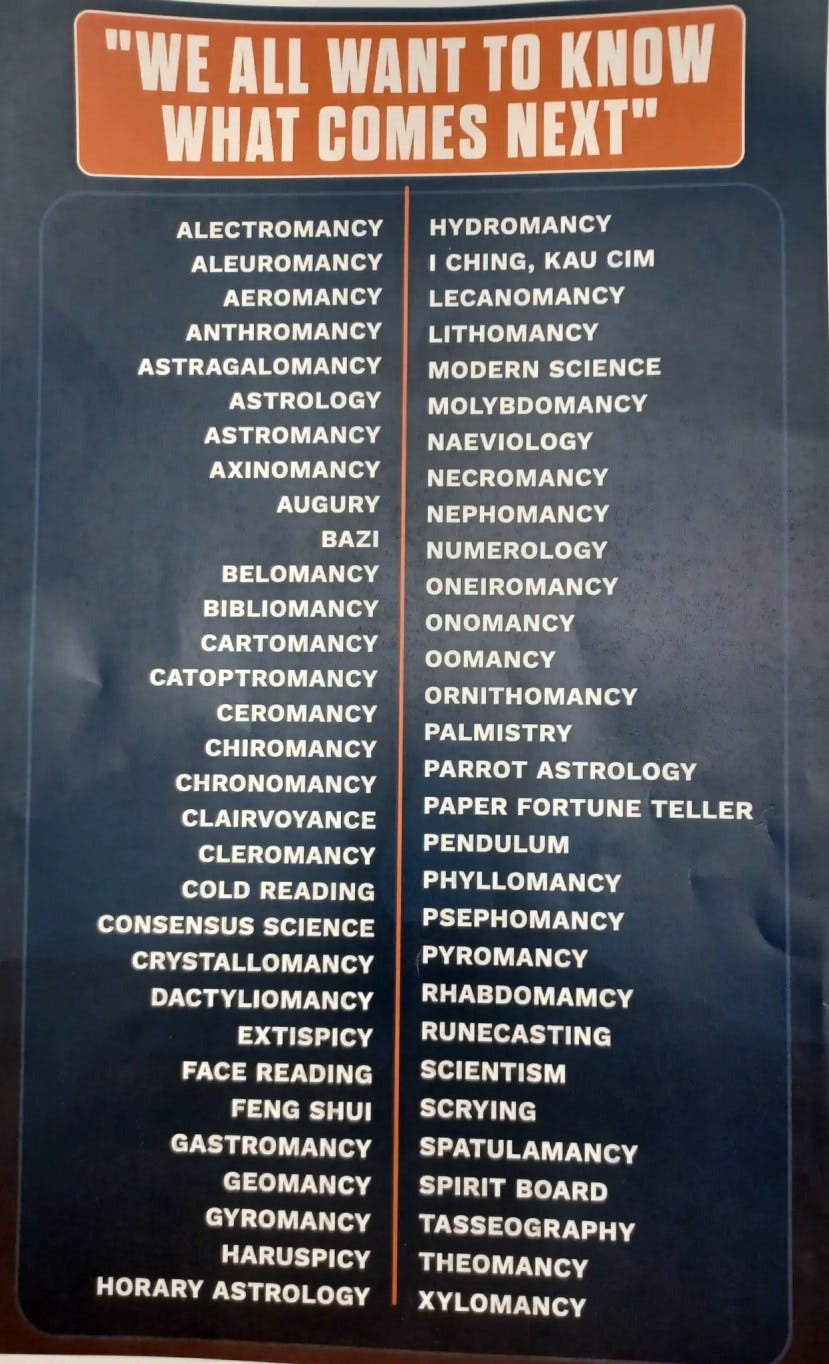How Do Scientists & Soothsayers Know When They’re Right? Report on Fourth Broken Science Initiative Event
We had the fourth Broken Science Initiative event this past Saturday at the Castro Ranch in Aromas, California. Which is apparently where CrossFit got its start. Standing room only. Terrific crowd. Good questions. Tacos. And a Mariachi band!
Greg Glassman and I spoke. The talks were recorded and will be put on the BSI YouTube page when they’re available. Now you’ve heard more than enough from me, and anyway you can watch my talk later, so I’ll tell you about Greg’s instead.
My favorite part was this “slide” of his (poster boards, with his very own Vanna White revealing them one by one).
You’ll recognize some of these, like numerology and clairvoyance. Others you might not know, like catoptromancy, which is a form of divination using mirrors. Or phyllomancy, which is divination using leaves. And not just veins on leaves, but the sound their rustling makes.
Not every form of divination—the art of foretelling the future—is on the list, which is large, and ever growing. We are all incurably curious about what will happen to us. Perhaps the most prominent absence is time series. Time series is a subset of numerology, a form of divination looking at patterns in numbers.
In time series, past numbers are scrutinized, and the patterns found within them are given mathematical form, forms which are said to have a sort of causal existence or power. These forms, which may be quantified by arcane complex alchemical formulae, or by simpler crude mathematical guides, are no different in spirit than the forms thought to be heard in the rustling in leaves.
Some of you will object and say some of these divination methods are “science”, and some are “pseudo-science”. The derogatory term is favored by scientists to dismiss unfashionable, and sometimes even unproductive, ideas.
To separate “science” from “pseudo-science” was, Greg reminded us, once a popular subject in philosophy called the “demarcation problem.” Philosophers, like our beating-bag Karl Popper, and scientists argued for years just what unique distinction there was between the two. The conclusion was that there is no conclusion. There is no thing that allows one to draw a line between what counts as science and what pseudo-science. We can tell that story another day.
Yet even if is there no demarcation, we can still separate good from bad science, useful from harmful science, and accurate and inaccurate science. Here the separation, philosophically, anyway, is easy. If the science makes good predictions, it is good science. If bad, then bad. Simple!
Simple idea, that is. Not so easy in real life.
All those methods of divination are science. Or sciences. But not all are good or useful science. What’s useful? You have heard me say hundreds of times that a model or theory can be useful to one man, and useless, and even harmful, to another. Like models for masks preventing the spread of respiratory diseases. Damn useful for the longhouse, and damned painful for its inhabitants.
Point is, usefulness and goodness depend on to what purposes the sciences are put. By science I mean models or theory, or just models, since to my mind these are the same.
The possibility of different uses for a science means it can be judged differently. The line is fuzzy.
It’s made fuzzier because of how a model’s predictions are seen.
Greg made the point over and over that a model (or science’s) value is in its predictive ability. This is true. And if this truth were generally acknowledged, the very practice of modern science would shift in a most dramatic fashion. Alas, scientists are content with announcing, nearly all the time, how beautiful their models are, and not how well they predict Reality. Predict bits of Reality never before seen or used in making the models, that is.
Maybe you scoffed at catoptromancy, thinking it absurd the future can be seen in mirrors. I too think this is not possible. But how is it practitioners think it is?
Same as any scientist following the predictive way! They make predictions according to their model, and then verify them. And they are extraordinarily creative about what counts as verification. Or what counts as proper predictions.
Scientists often hide their predictions by calling them “scenarios” or the like. But all predictions are of the form “If X, then Y (plus or minus)”. X is the set of conditions that hold in the world. If X is true, then Y (plus or minus) is a prediction, and not a “scenario.”
But you can imagine that often X can be quite dense, a tangled compound proposition open to interpretation—after the fact. The same is true for Y. Nuances and shades of meaning shift n in the verification.
This happens with all methods of divination by scientists of all stripe anxious to retain their theories. Think of both global climate models and clairvoyance.
This is why in any true test of a science, the verification must be specified in rigorous exactitude, carried out by disinterested parties, which no after-the-fact excuses allowed.
Which has been the case in many psychic science claims. But which hasn’t been done, not so far, in “climate change” models.
More to come!
Subscribe or donate to support this site and its wholly independent host using credit card click here. Or use the paid subscription here. Cash App: $WilliamMBriggs. For Zelle, use my email: matt@wmbriggs.com, and please include yours so I know who to thank.






Solipsism is predictively rife among climate change models who undress on NYC subway cars during abnormally hot days and practice catoptromancy by taking smart phone selfies of their sweating bodies.
💬 which no after-the-fact excuses allowed.
Your enemies managed to insert only the puniest of typos—likely appalled at the blinding clarity of your writing 🤭